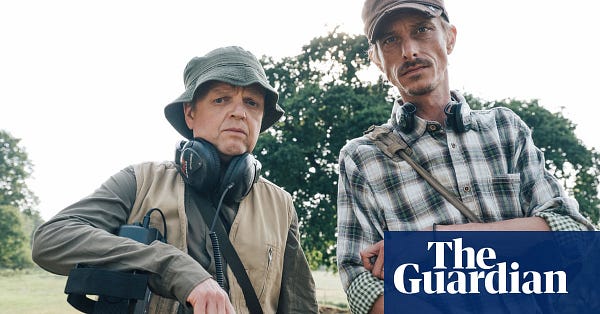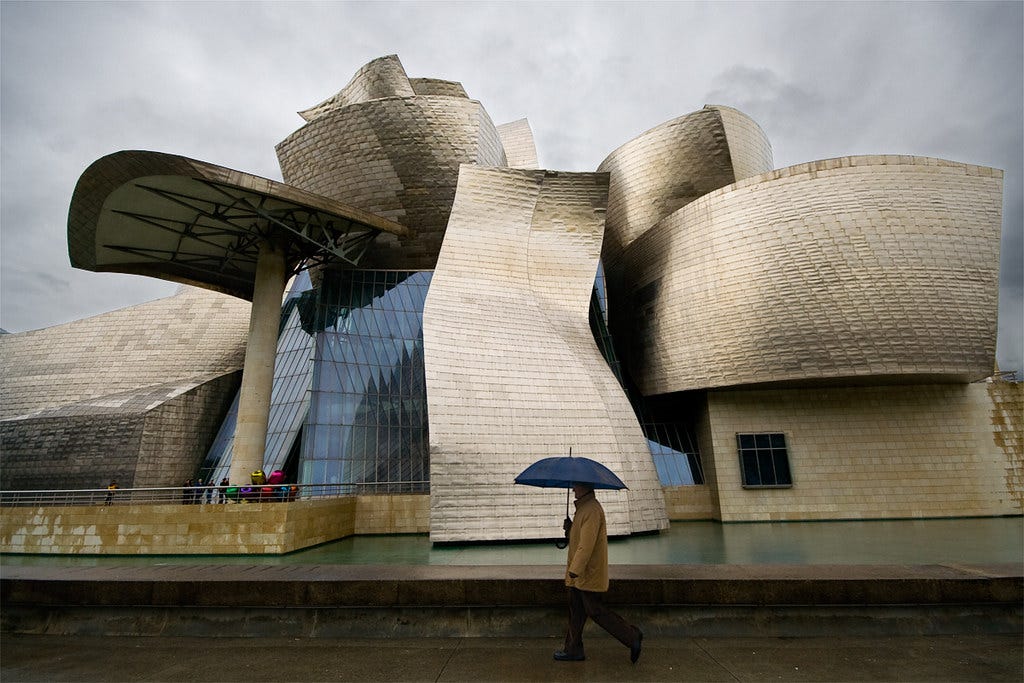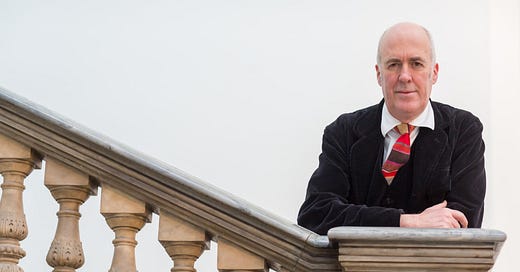Spring has well and truly sprung here in the UK. Hurrah! Ok, it might not last, but my god isn’t everything better in the sunshine? And now the clocks have gone forward, it feels like we’re on the up. To my readers in the southern hemisphere: hang in there.
My interview today is a biggie, a titan of the British museum scene for the three decades. Charles Saumarez Smith has led three huge UK institutions: the National Portrait Gallery, the National Gallery, and the Royal Academy. I’ve chatted to him on the occasion of the publication of his brand new book on the history of the modern art museum. It’s fab, and I’m hugely excited to say I’m also giving you the chance to win a copy! Read on to find out how to enter. (There were also more questions for Charles than I could fit into this newsletter, so you can skip straight to the full interview here).
And don’t forget to check out my newly-launched Classfied ads at the bottom of each newsletter. If you want to see your project featured, hit reply to this email to ask for rates.
Love museums? Then you’ll love my newsletter. I send a round up of museum news every Friday, and every two weeks a jam-packed edition of original features including interviews. Subscribe to get the next edition.
barometer
What’s heating up and cooling down in the world of museums this week.
going up
The year 2022. Admittedly, any year following the literal horror movie that is 2020 (and its sequel 2020 Returns, aka 2021) is going to seem like a glorious 365-day trip to Disneyland (as long as the pandemic, you know, ends). But 2022 is really shaping up to be a blockbuster year, especially for culture lovers. Firstly, everyone in the UK gets an extra bank holiday to celebrate the Queen’s platinum jubilee. An extra day to visit museums - what’s not to love? Secondly, Birmingham will host the Commonwealth Games, and the accompanying cultural programme will see more than 200 creative projects and artworks commissioned. And finally, last week Festival UK 2022 has announced its participants for the big £120m jamboree which will show off Britain and its creative genius to the world. (And yes it is dubbed the Festival of Brexit but even the Guardian are on board, ok). Only 277 days to go…
going down
BBC Four. The channel that’s been the BBC’s main home for arts, culture and documentaries over the past 20 years (including hits such as Britain’s Lost Masterpiece and the excellent and swiftly-produced Museums in Quarantine series at the start of the pandemic) was put on life support by the corporation yesterday. It will no longer commission new shows, and will instead only run repeats of BBC archive content. High-profile historians and more reacted with dismay on Twitter. I’m sure the only people welcoming the news were the team at the newly free-to-air Sky Arts.


museums: curated
Since the pandemic hit, this section has had to branch out from its long-term purpose of being a space to recommend brand new exhibitions to visit. I’m now making the change permanent. So you will continue to see IRL shows here, but you’ll also now always see other exciting highlights, such as TV shows, events, publications, online exhibitions and even brand new museums. It’s my curated list of what’s new in art, museums and galleries.
New Book - the National Portrait Gallery announces its pandemic photography exhibition led by the Duchess of Cambridge is being turned into a glossy hardback book. Hold Still, supported by Co-op, will feature all 100 of the final portraits. Published 7 May 2021
New Shop - Get your gifts and help a museum all in one. Birmingham Museums’ new online shop celebrates the best of England’s second city with a unique range of products created by the very best local independent makers. Shop now
New Exhibition - an exhibition of new work by the excellent Rachel Whiteread comes to London. Instead of casting existing spaces, here she builds brand new ones. At Gagosian Grosvenor Hill, London from 12 April
interview
There are few people more qualified to examine the evolution of the art museum than Sir Charles Saumarez Smith. Over nearly 25 years he was at the helm of some of the UK’s biggest art institutions: he was appointed Director of the National Portrait Gallery in 1994, Director of the National Gallery in 2002 and finally Secretary and Chief Executive of the Royal Academy (RA) in 2007. He knows what makes art museums tick.
It’s this experience that makes his new book, the Art Museum in Modern Times, such a fascinating read. It canters through nearly a century of change in art museums across the world through forty-one case studies - before looking at where museums might be headed in the future. He begins with the Museum of Modern Art in New York in 1939, before taking in some of the world’s biggest institutions including Tate Modern and the Saatchi Gallery in London, the Getty Center in Los Angeles, the Whitney Museum in New York, and the Centre Pompidou in Paris – as well as the Pompidou’s new Shanghai branch West Bund, which opened in 2019. It traces a radical shift from a belief that museums can and should instruct and educate, to the idea that museums should be more about contemplation, spectacle and individual experience. It’s a must read for museum-lovers, with Saumarez Smith being your clear and insightful guide on this absorbing journey. I spoke to him to find out more.
***
You were at the helm of three major institutions during seemingly golden years for UK museums. What was this time like?
Of course, in retrospect, the last thirty years looks like boom time! And, I think I was aware, even at the time, that I was privileged to arrive as Director of the National Portrait Gallery just after the Heritage Lottery Fund had become available, so that I was able to sit down with senior staff and talk about what we should do, with a reasonable degree of confidence that anything suggested would be possible. In fact, the Ondaatje Wing ended up being vastly more ambitious and adventurous than envisaged when we first drew up the brief, because of a sense of optimism in the period leading up to the Millennium. So, I look back on the 1990s as a period of hope and opportunity – introducing more big photographic exhibitions, broadening the remit of the collection and totally redisplaying it. Life at the National Gallery felt much tougher: never-ending important acquisitions, starting with the Madonna of the Pinks, each of which was a titanic struggle and several of which ended in ignominious failure. Maybe the government grant did go up, but only by inflation and the wage bill and costs would have increased more, so it didn’t feel like a time of plenty. Then, I moved to the Royal Academy, partly because I like big building projects and knew that the old Museum of Mankind building was the last remaining unreconstructed building in central London. What was most enjoyable at the Royal Academy was the big exhibitions: Byzantium and Bronze; Kapoor, Hockney and Kiefer. People underestimate the huge impact of the National Lottery and how it has transformed the world of culture.
Your new book details the changing nature of art museums over the past century, through individual case studies. Which do you think has had the biggest impact? And which is the most under-recognised for its impact?
I think the Centre Pompidou had a big impact, demonstrating that it was possible to do things very differently. The museum that I think has been least well recognised is the Musée d’Orsay, which I have always found impressive and interesting in the way it is laid out, but seems to have had a pretty consistently bad press, both for its architecture and in the way the collection is arranged. Maybe because it is a bit theatrical and postmodernism is so out of fashion at the moment, which means that people also under-rate the historical significance not just of the Musée d’Orsay, but Jim Stirling’s design of the Neue Staatsgalerie in Stuttgart and the Sainsbury Wing as well.
You say that art museums are under attack? Why?
Several people have felt that the conclusion which I wrote in April 2020 just after the outbreak of Coronavirus exaggerates the feeling of attack. But I do think that there are several obvious forms of current hostility towards the idea of the museum which have collided in the last year: a deep opposition to the way that Anglo-American museums are run, financed and dominated by interests of the ultra-rich; a feeling that the canon needs to be radically adjusted in order to show the work of artists whose work has traditionally been excluded; the movement behind restitution; and, lastly, Black Lives Matter. All of these in combination are creating an environment in which the museum is seen less as a democratic force for public enlightenment, and more as if it has been nothing more than a tool of Eurocentric imperialism.
The book also looks to the future - but says that “uncertainty is more absolute than at any previous time.” How worried should we be?
I ended the book on a positive note, not a negative one, because what the book demonstrates, I hope, is how resilient and adaptable the museum model has been. I hugely admired the 21st. Museum of Contemporary Art in Kanazawa, which was not an especially expensive project, but a highly inventive one and there are lots of big projects due to open in the future, including a totally reconstructed National Portrait Gallery and the V&A East. So, I don’t think we need to be so worried. As we begin to come out of COVID, there are signs of new optimism, so maybe 2020 was an apocalyptic moment which will produce a rebalancing and a reorientation of the museum project which will be healthy and not destructive.
Two of your own major projects get chapters in the book: the Ondaatje Wing at the National Portrait Gallery and the 250th anniversary revamp of the RA. What kept you awake the most while working on these projects?
I look back on the Ondaatje Wing as having been an astonishingly and, in retrospect, ridiculously straightforward project. I arrive at the NPG in January 1994. We had selected Jeremy Dixon and Edward Jones by the end of my first year. We got the majority of the funding from the Heritage Lottery Fund. My biggest anxiety was the day before it opened as to whether or not people would find their way up to the restaurant on the roof as I had insisted that the escalator should go no further than the Tudor Gallery. The revamp of the RA was much more of a headache, mainly to do with funding, but also the whole management of the project and containing its cost. However hard one tries and whatever form of contract is used, it seems to be very hard, if not impossible, to deliver a big capital project within budget. I think the Heritage Lottery Fund should do more to share knowledge and advice on best practice in project management.

The Art Museum in Modern Times also discusses the recent trend for satellite museums and the franchising out of brands and collections, such as with the Louvre Lens, Guggenheim Bilbao and West Bund (a collaboration with the Centre Pompidou). Should we expect - and would it be desirable - to see the National Gallery or RA follow this route?
One of my big regrets is that the National Portrait Gallery did not open a satellite, as we planned in the late 1990s in Durham, for its enormous twentieth-century collection, which could be a rich resource for a museum of twentieth-century history. The National Gallery’s collection is not large enough to have a full satellite, but is rightly very generous with loans. At the Royal Academy, we did consider the possibility of having satellites in other parts of the world, including Singapore and Hong Kong, for travelling exhibitions. I certainly felt it could be a very good idea to send out a programme of small-scale contemporary exhibitions internationally. But the next decade is likely to be one of managing resources, not expansionism.
The next major new UK museum will be V&A East in Stratford, East London. Will it be as
transformational as Tate Modern?
For me, the most interesting part of V&A East is not so much the new exhibition space, designed by O’Donnell + Tuomey, which looks to me to be aversion of a kunsthalle, but Here East [a nearby new collection and research centre, designed by Diller Scofidio + Renfro, which is a reinterpretation of the idea of visible storage, perhaps a version of what the V&A once was, which was acres of publicly accessible storage cabinets laid out for public and educational benefit as a kind of material culture school room. But it is hard to imagine that it will have quite the impact of Tate Modern which was such a huge public investment in, and commitment to, the culture of the modern - a revolution not just in terms of museums, but Britain’s whole attitude to contemporary art.
The Art Museum in Modern Times, published by Thames & Hudson, is out in hardback now
Read the full interview with Charles Saumarez Smith here
competition
I’m really excited to say I’ve teamed up with Thames & Hudson, the publisher of The Art Museum in Modern Times, to offer you the chance to win one of two copies of the brand new book. It’s an exclusive competition for you, my loyal readers.
To win: just hit replay to this email, and send me your name and I WANT THIS BOOK in the subject line. That’s all you need to do! I’ll pick a winner at random from all entries received by 23:59 on 6 April, and will contact you by email if you're a lucky winner. Just remember: you must be subscribed to this newsletter to be eligible. GOOD LUCK.
and finally
What does a museum do when forced to close for months? At the V&A, they’ve cleaned, repaired, renovated, bubblewrapped – and kept burglars at bay. The Guardian were given a special tour to find out what’s been happening while the shutters have been down. Read it here
classifieds
Talking Travel Writing is a free, highly insightful newsletter for journalists who want to thrive in the world of travel writing. It offers editor interviews, expert advice and pitch call outs, and there's 20% off the paid version until 6 April.
Classifieds are paid ads that support maxwell museums. Book yours by replying to this email to ask me for rates.
Love museums? Then you’ll love my newsletter. I send a round up of museum news every Friday, and every two weeks a jam-packed edition of original features including interviews. Subscribe to get the next edition.





